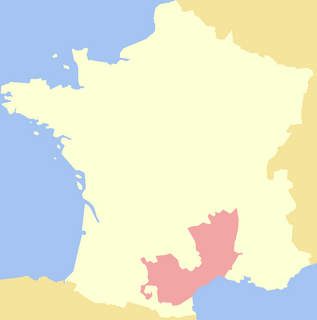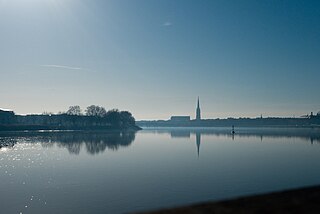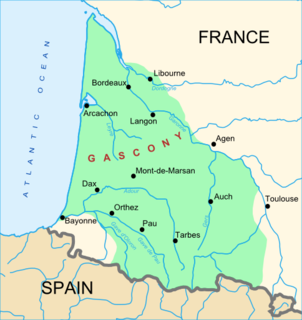
The Champagne wine region is a wine region within the historical province of Champagne in the northeast of France. The area is best known for the production of the sparkling white wine that bears the region's name. EU law and the laws of most countries reserve the term "Champagne" exclusively for wines that come from this region located about 100 miles (160 km) east of Paris. The viticultural boundaries of Champagne are legally defined and split into five wine producing districts within the historical province: Aube, Côte des Blancs, Côte de Sézanne, Montagne de Reims, and Vallée de la Marne. The towns of Reims and Épernay are the commercial centers of the area. Reims is famous for its cathedral, the venue of the coronation of the French Kings and a Unesco world heritage site.

Mosel is one of 13 German wine regions (Weinbaugebiete) for quality wines , and takes its name from the Mosel River. Before 1 August 2007 the region was called Mosel-Saar-Ruwer, but changed to a name that was considered more consumer-friendly. The wine region is Germany's third largest in terms of production but some consider it the leading region in terms of international prestige. The region covers the valleys of the rivers Mosel, Saar, and Ruwer from near the mouth of the Mosel at Koblenz and upstream to the vicinity of Trier in the federal state of Rhineland-Palatinate. The area is known for the steep slopes of the region's vineyards overlooking the river. At 65° degrees incline, the steepest recorded vineyard in the world is the Calmont vineyard located on the Mosel and belonging to the village of Bremm, and therefore referred to as Bremmer Calmont. The Mosel is mainly famous for its wines made from the Riesling grape, but Elbling and Müller-Thurgau also contribute to the production, among others. In the past two decades red wine production, especially from the Spätburgunder, has increased in the Mosel and throughout the German vignoble and has become of increasing interest to the international wine community. Because of the northerly location of the Mosel, the Riesling wines are often light, tending to lower alcohol, crisp and high in acidity, and often exhibit "flowery" rather than or in addition to "fruity" aromas. Its most common vineyard soil is derived in the main from various kinds of slate deposits, which tend to give the wines a transparent, mineralic aspect, that often exhibit great depth of flavor. In the current era of climate change much work has been done to improve and gain acceptance for completely dry ("Trocken") Rieslings in this region, so that most of the more famous makers have found acceptance for such wines, particularly in Europe.

Graves is an important subregion of the Bordeaux wine region. Graves is situated on the left bank of the Garonne River, in the upstream part of the region, southeast of the city Bordeaux and stretches over 50 kilometres (31 mi). Graves is the only Bordeaux subregion which is famed for all three of Bordeaux' three main wine types—reds, dry whites and sweet wines—although red wines dominate the total production. Graves AOC is also the name of one Appellation d'origine contrôlée (AOC) which covers most, but not all of the Graves subregion.

Condrieu is a French wine-growing Appellation d'Origine Contrôlée (AOC) located in the northern Rhône, near Vienne and to the south of the Côte-Rôtie AOC. The vineyards are situated in the seven communes of Limony, Chavanay, Malleval, Saint-Michel-sur-Rhône, Saint-Pierre-de Boeuf, Vérin, and Condrieu. These communes are in the French departments of Ardèche, Rhône and Loire on the steep slopes of the foothills of the Massif Central on the right bank of the Rhône. The four southernmost communes can also produce wine under the Saint-Joseph AOC. The wines made in this AOC are exclusively white, from the Viognier grape, which may have originated in the region. Within Condrieu is the enclave AOC of Château-Grillet, producing wines that are also 100% Viognier. The Condrieu AOC was officially created in 1940.

Bodegas Vega Sicilia is a Spanish winery located in the Ribera del Duero Denominación de Origen in the Province of Valladolid, Castile and León. The winery was founded in 1864 by Don Eloy Lecanda y Chaves, who planted various grapes from the Bordeaux wine region of France, including Cabernet Sauvignon and Merlot, which are still being used in the wines today.

Sauternes is a French sweet wine from the Sauternais region of the Graves section in Bordeaux. Sauternes is made from Sémillon, Sauvignon blanc, and Muscadelle grapes that have been affected by Botrytis cinerea, also known as noble rot. This causes the grapes to become partially raisined, resulting in concentrated and distinctively flavored wines. Due to its climate, Sauternes is one of the few wine regions where infection with noble rot is a frequent occurrence. Even so, production is a hit-or-miss proposition, with widely varying harvests from vintage to vintage. Wines from Sauternes, especially the Premier Cru Supérieur estate Château d'Yquem, can be very expensive, due largely to the very high cost of production. Barsac lies within Sauternes, and is entitled to use either name. Somewhat similar but less expensive and typically less-distinguished wines are produced in the neighboring regions of Monbazillac, Cérons, Loupiac and Cadillac. In the United States, there is a semi-generic label for sweet white dessert wines known as sauterne without the "s" at the end and uncapitalized.
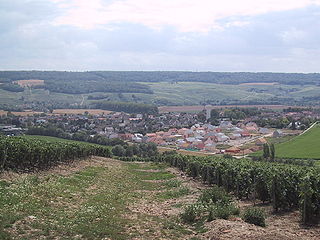
The Champagne Riots of 1910 and 1911 resulted from a series of problems faced by grape growers in the Champagne area of France. These included four years of disastrous crop losses, the infestation of the phylloxera louse, low income and the belief that wine merchants were using grapes from outside the Champagne region. The precipitating event may have been the announcement in 1908 by the French government that it would delimit by decree the exact geographic area that would be granted economic advantage and protection by being awarded the Champagne appellation. This early development of Appellation d'Origine Contrôlée regulation benefitted the Marne and Aisne districts to the significant exclusion of the Aube district which included the town of Troyes—the historic capital of the Champagne region.
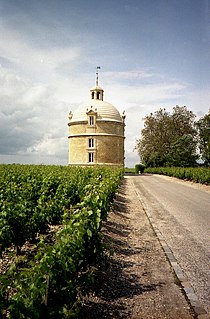
The history of Bordeaux wine spans almost 2000 years to Roman times when the first vineyards were planted. In the Middle Ages, the marriage of Henry Plantagenet and Eleanor of Aquitaine opened the Bordeaux region to the English market and eventually to the world's stage. The Gironde estuary and its tributaries, the Garonne and the Dordogne rivers play a pivotal role in the history and success of this region.

The history of Rioja wine reflects a long and varied winemaking tradition in the Spanish region of La Rioja, starting with the first Phoenician settlers in 11th century BC. As with many of Europe's most well known wine regions, the Ancient Romans founded many of the Rioja vineyards. Throughout the Middle Ages, pilgrims to the shrine of St. James at Santiago de Compostela passed through the region and carried back with them the reputation of wines from the area. The phylloxera epidemic of the late 19th century was a major catalyst in the expansion and modernization of the Rioja wine industry, with the devastation the French wine industry both opening up the French wine market and bringing an influx of French investment into the region. Today, together with Sherry, Rioja is the most internationally recognized of all Spanish wines.

The history of Sherry is closely linked with that of Spanish wine production, particularly the political fortunes of the Cádiz region, where it originated with the early Phoenician settlement of the Iberian Peninsula. The triangular region between the towns of Jerez de la Frontera, El Puerto de Santa María, and Sanlúcar de Barrameda still marks the limits of the modern denominación. One of the world's oldest wines, its considerable evolution has been marked by the influence of many of the world's greatest empires and civilizations: the Phoenicians, Greeks, Romans, Moors, Spanish and British. Today, while Sherry does not enjoy the level of popularity it once did, it remains one of the wine world's most unusual and historical expressions.
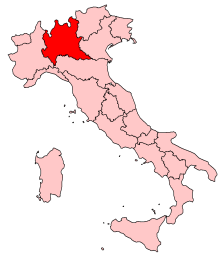
Lombardia (Lombardy) wine is the Italian wine produced in the Lombardy region of north central Italy. The region is known particularly for its sparkling wines made in the Franciacorta and Oltrepò Pavese areas. Lombardy also produces still red, white and rosé wines made from a variety of local and international grapes including Nebbiolo wines in the Valtellina region, Trebbiano di Lugana white wines produced with the Chiaretto style rosé along the shores of Lake Garda. The wine region currently has 15 Denominazione di origine controllata (DOC), 3 Denominazione di Origine Controllata e Garantita (DOCG) and 13 Indicazione Geografica Tipica (IGT) designations. The main cities of the region are Milan, Bergamo and Brescia. The region annually produces around 1.3 million hectolitres of wine, more than the regions of Friuli-Venezia Giulia, Marche, Trentino-Alto Adige/Südtirol and Umbria.

Ancient Rome played a pivotal role in the history of wine. The earliest influences on the viticulture of the Italian peninsula can be traced to ancient Greeks and the Etruscans. The rise of the Roman Empire saw both technological advances in and burgeoning awareness of winemaking, which spread to all parts of the empire. Rome's influence has had a profound effect on the histories of today's major winemaking regions in France, Germany, Italy, Portugal and Spain.
Henri Enjalbert was a French professor of geography at the University of Bordeaux. He was considered an eminent specialist in wine geology, whose expert opinion frequently overlapped into the fields of oenology, and wine and terroir history, within the Bordeaux region and beyond. Among other credits, he has been called "Bordeaux's most diligent geologist" and "the discoverer of Mas de Daumas Gassac. Among his contentions are that Albania, the Ionian Islands of Greece, and southern Dalmatia in present-day Bosnia-Herzegovina may have been the last European refuge of the grape vine after the Ice Age.
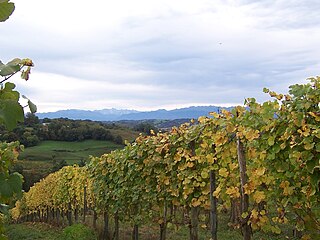
South West France, or in French Sud-Ouest, is a wine region in France covering several wine-producing areas situated respectively inland from, and south of, the wine region of Bordeaux. These areas, which have a total of 16,000 hectares of vineyards, consist of several discontinuous wine "islands" throughout the Aquitaine region, and more or less to the west of the Midi-Pyrénées region.

The history of French wine, spans a period of at least 2600 years dating to the founding of Massalia in the 6th century BC by Phocaeans with the possibility that viticulture existed much earlier. The Romans did much to spread viticulture across the land they knew as Gaul, encouraging the planting of vines in areas that would become the well known wine regions of Bordeaux, Burgundy, Alsace, Champagne, Languedoc, Loire Valley and the Rhone.

The classification of Champagne vineyards developed in the mid-20th century as a means of setting the price of grapes grown through the villages of the Champagne wine region. Unlike the classification of Bordeaux wine estates or Burgundy Grand cru vineyards, the classification of Champagne is broken down based on what village the vineyards are located in. A percentile system known as the Échelle des Crus acts as a pro-rata system for determining grape prices. Vineyards located in villages with high rates will receive higher prices for their grapes than vineyards located in villages with a lower rating. While the Échelle des Crus system was originally conceived as a 1-100 point scale, in practice, the lowest rated villages are rated at 80%. Premier crus villages are rated between 90 and 99 percent while the highest rated villages, with 100% ratings are Grand crus.

Grower Champagnes are those Champagnes that are produced by the same estate that owns the vineyards where the grapes are grown. Récoltant-Manipulant is the term in French, and Grower Champagnes can be identified by "RM" on the wine label. While large Champagne houses, such as Mumm, Moët et Chandon, Veuve Clicquot and others may use grapes sourced from as many as 80 different vineyards in the Champagne region to create a consistent house style, Grower Champagnes tend to be more terroir-focused, being sourced from a single vineyard or closely located vineyards around a village, and made with grapes which vary with each vintage. Today there are over 19,000 independent growers in the Champagne region, accounting for nearly 88% of all vineyard land in the region; around 5,000 of these growers produce wine from their own grapes. Of the Champagne imported into the US in 2014, only 5% was grower Champagne.
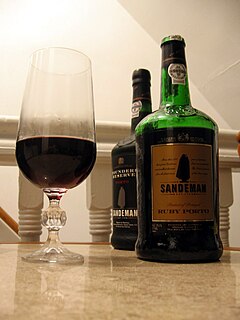
The history of Portuguese wine has been influenced by Portugal's relative isolationism in the world's wine market, with the one notable exception of its relationship with the British. Wine has been made in Portugal since at least 2000 BC when the Tartessians planted vines in the Sado and Tagus valleys. By the 10th century BC, the Phoenicians had arrived and introduced new grape varieties and winemaking techniques to the area. Up until this point, viticulture was mostly centered on the southern coastal areas of Portugal. In later centuries, the Ancient Greeks, Celts and Romans would do much to spread viticulture and winemaking further north.

The Douro Wine Company was a government oversight organization established by the Portuguese Prime Minister Sebastião José de Carvalho e Melo, Marquis of Pombal to regulate the trade and production of Port wine. Established in 1756, one of the first official duties of the company was the delineation of the boundaries of the Douro wine region. This act essentially made the Douro the world's first regional appellation. While the boundaries of the Chianti and Tokaji wine regions were outlined in 1716 and 1737, respectively, neither of these regions were "technically" appellations in the sense of being subjected to continued government control and regulations. Under their charter, Pombal invested an immense amount of control in the Douro Wine Company to regulate all exports of Port, set production quantities limits, fix maximum and minimum prices for grapes and to serve as sole arbitrator in any disputes between vine growers and Port shippers. In 1761, the company was further granted a monopoly on the sale of brandy which was used in the fortification process of Port winemaking. The Douro Wine Company continued to operate to 1833. Today, many of it functions have been deregulated with the Instituto dos Vinhos do Douro e do Porto or being the official regulating body of Port wine and Douro table wine production.

The Quinta classification of Port vineyards in the Douro is a system that grades the terroir and quality potential of vineyards in the Douro wine region to produce grapes suitable for the production of Port wine. In Portuguese, a quinta is a wine producing estate, which can be a winery or a vineyard. While other wine classification systems may classify the winery, the Douro quinta classification is based upon the physical characteristics of the vineyard. The classification system is run by the Instituto dos Vinhos do Douro e Porto (IVDP) and shares some similarities to the classification of Champagne vineyards in that one of the purposes of the system is to ensuring that vineyards producing grapes with the highest quality potential receive a high price. A secondary function of the quinta classification is the establishment of permitted yields for production. Quintas with a higher classification are permitted to harvest more grapes than a vineyard that received a lower classification.



